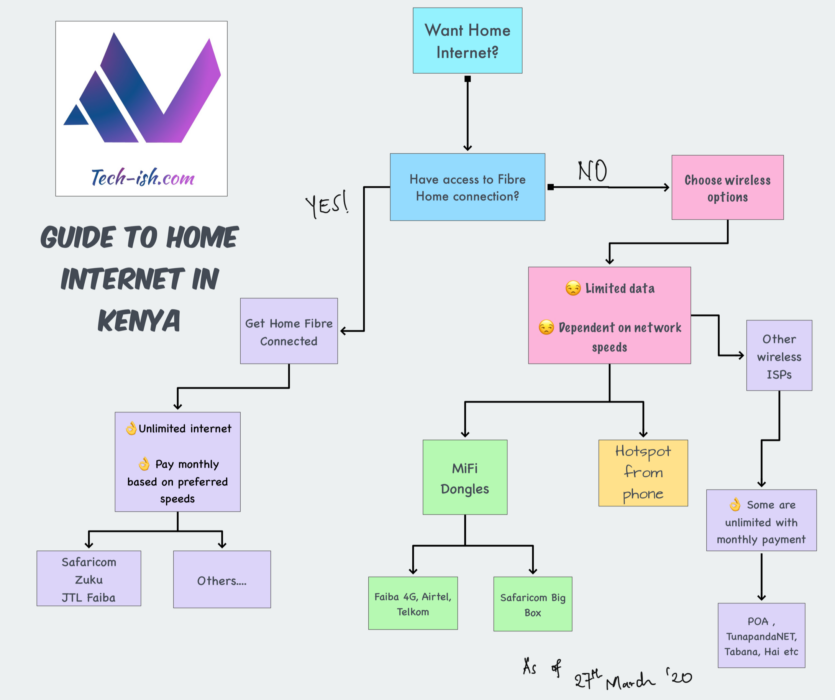
Download above Infograhic here
As people stay at home due to the ongoing situation worldwide, interest in Kenya on Home Internet solutions is very high. I’ve received numerous emails on people asking about the Faiba MiFi, and many calls on people inquiring on what they can do to get good and affordable home internet.
This post tries to explain what you can do if you’re looking for a reliable Home Internet solution for where you live. The main thing to remember is that your location really affects what sort of home internet solution you can get.

There are two main options to choose from when thinking about Home internet.
- Home Fibre connection – If you live in an area with Fibre access.
- Wireless connection – which gives you two main options either: Buying a MiFi. Or using your phone as a hotspot. There’s also the option for other wireless ISPs depending on where you live.
Home Fibre Connection:
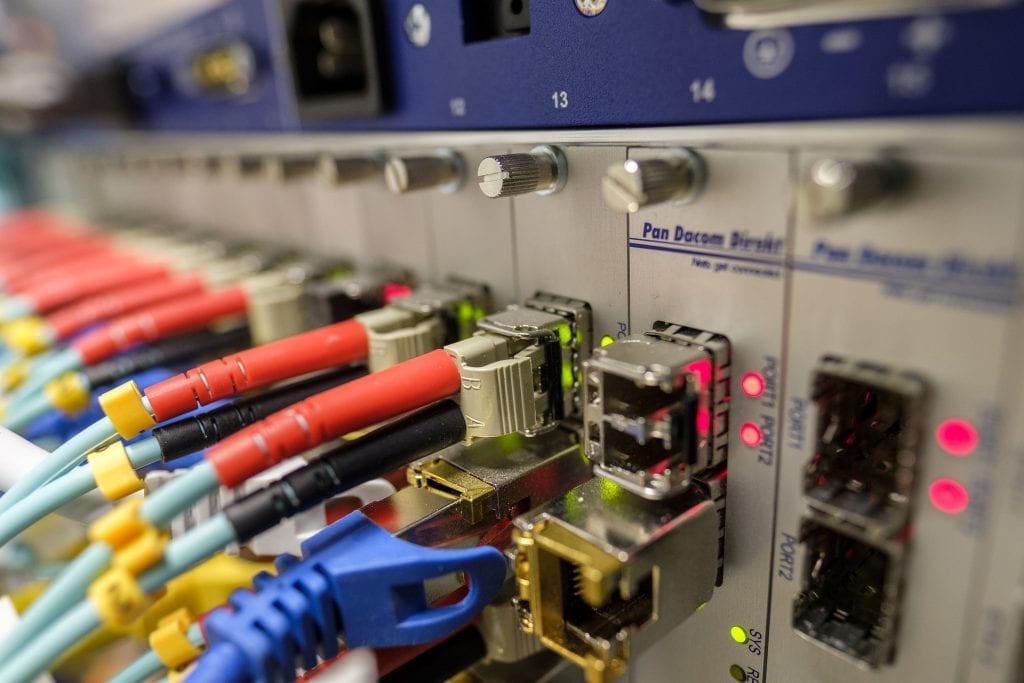
In Kenya, the main companies providing home fibre internet connections are:
- Safaricom Home Fibre
- Zuku Home Internet
- Jamii Telecoms Faiba (JTL) Home Internet
There are also other providers like Access Kenya, Hai Internet, Skynet, POA internet, Tabana, Elink Networks among many more.
If you live in an area where either of them is available, you will have seen them advertise around your area. Connection to your home or house depends on where the fibre cable has reached. Some people will have to pay extra fees to have the fibre reach them, while some may already live in houses or apartments that are fibre ready. So all you need to do is call either Safaricom, Zuku or JTL to ask them to connect you.
Payment is done on a monthly basis, and you get unlimited internet. Meaning you can use up as much as you want to through the month. The only thing is that your internet speeds will vary depending on what you have paid. For example on Safaricom, a connection speed of 5MBPS will cost you KES. 2,900 a month. Zuku and JTL have different prices for different speeds.
Safaricom has the widest coverage in Kenya of the Home Fibre connection. If you’re in Kisumu, Mombasa, Nairobi, Kiambu, you are probably near an area with Safaricom Home Fibre.
Zuku and JTL Faiba are yet to properly expand their home fibre solutions. In the coming years, we can expect very many homes to be connected with fibre internet.
The advantage of Fibre connections is that you get unlimited internet. You can do all you want.
Wireless Connections:
This is what most Kenyans have to make do with because most areas in Kenya aren’t fibre ready.
If you don’t live in an area with home Fibre internet, you have the option of either:
- Buying a MiFi dongle or
- Using your Phone as a hotspot.
- or getting other wireless ISPs who are very rare to find.
Both these options involve either buying bundles or getting into a plan that works for you.
Unlike with Fibre connections, speeds on MiFis and Hotspotting are set based on where you are and whether you’re on 4G or 3G. You also don’t get unlimited internet like with Fibre connections.
NOTE: I know there’s some options especially with Telkom that say unlimited internet, but remember this doesn’t work as advertised, after sometime you’ll have very very slow internet due to FUP (Fair Usage Policy)
MiFi Dongles:
Before buying a MiFi dongle, there’s a couple of things you need to consider:
- Is it 3G or 4G? – You want 4G for the fastests speeds. Almost all MiFis currently are 4G ready.
- What’s the best network where I live – You want to have the strongest network where you live so as not to have any connection issues.
- Which provider has the best prices? – Who will give you the best bundle prices, so as not to make your life difficult with expenses? You can compromise between price and network speed by the way, to get a good middle ground.
You can get MiFi dongles from either Telkom, Airtel, or Faiba 4G. With these dongles, you can either choose between buying bundles for the SIM card in the dongle, or getting into a plan offered by the network.
Faiba 4G MiFi:
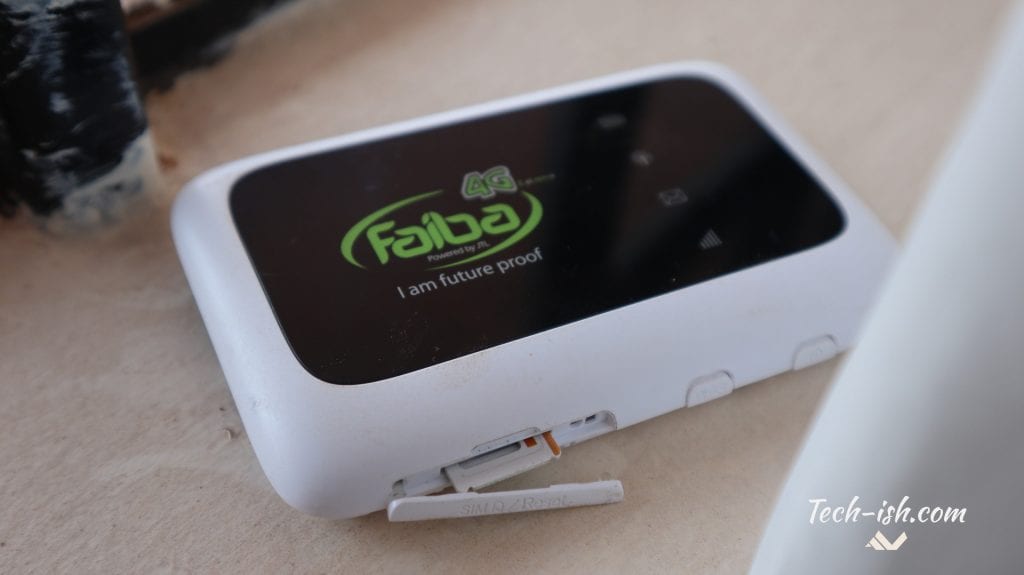
I’ve already talked about the Faiba 4G MiFi dongle. So read about it. Faiba 4G has the best bundle prices in Kenya currently with 25GB going for as little as KES. 1000. The issue is most areas still don’t have coverage. So you have to see if where you live has coverage.
Airtel MiFi:
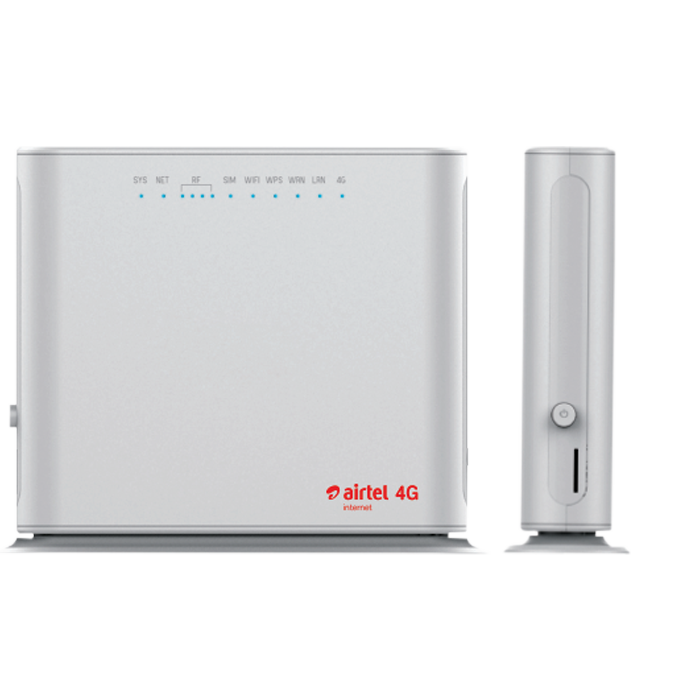
Airtel Kenya has a MiFi dongle called the Airtel Smart Home that’s just weird. I wrote about it here. I wouldn’t recommend getting it because of the price and the fact that it does what you can easily do by just tethering your phone. But it could work for a couple of people, so don’t rule it out.

Airtel also has another MiFi dongle that looks like Faiba 4G’s one. It is the one I believe you should consider. It will work really well for people living in areas where Airtel is the strongest network.
Telkom Kenya MiFi:
The Telkom Kenya MiFis will look exactly like Faiba 4G’s and Airtel’s second option.
Safaricom MiFi?
For Safaricom, you have the option of either buying MiFis that will work with all networks or getting the Safaricom Big Box which is a smart TV box that brings both free to air channels, AndroidTV goodness, and internet connectivity via 4G. Read all about the Big Box here. Its price was recently reduced.
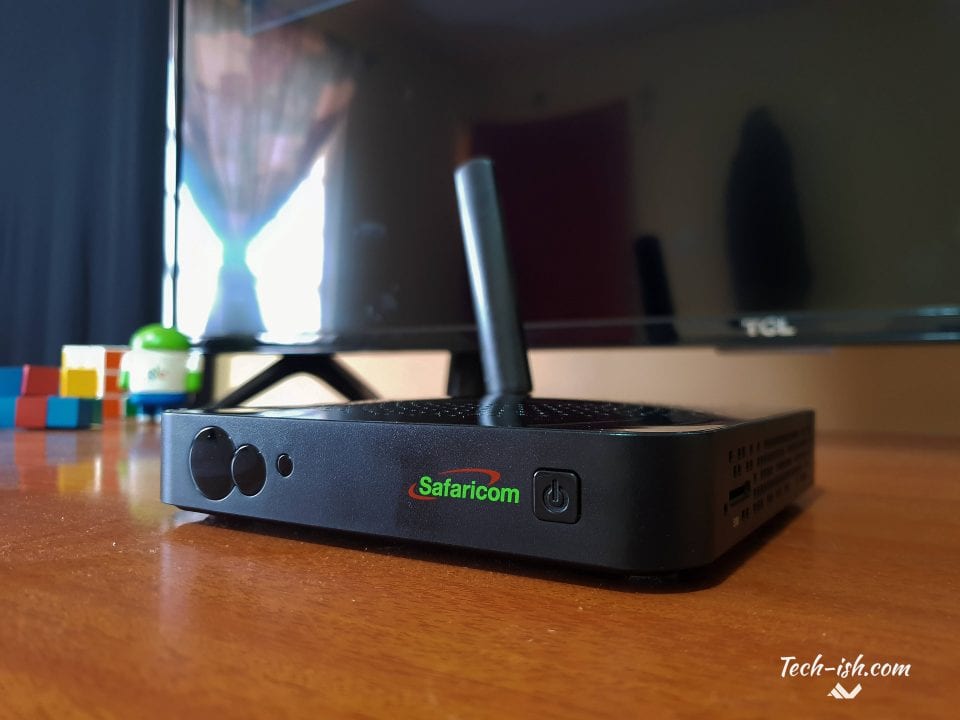
Using your Phone as a Hotspot:
For many people though, getting a MiFi dongle could be a quite costly venture. Why get one when your phone can already act as one, others may ask. And for those people, the solution is to just buy a SIM card, or use your current SIM card and buy bundles or get into a plan, then put the hotspot on. It works.

The problem with both MiFis and using your phone as a hotspot is that bundles can be very expensive. You will find yourself running out of bundles very quickly if you stream a movie or if you upload a big file.
Other Wireless Connections:
Some of the companies listed in Home Fibre above also have dedicated Wireless Connection solutions. These include:
- Safaricom LTE Business connection – targeted to businesses but some people get it for their homes.
- Tabana Wireless
- Hai Internet with their Hai-Max connection
- Skynet WiMax
- POA internet and many others
Each of these has different prices. But the good thing is you get to enjoy unlimited internet. The bad thing is they don’t cover most of the country, and are only currently in certain parts of Nairobi, and Kiambu. Whenever they’re around where you live, you’ll see posters, and you can try them out.
In the comment section, please add in any other home solutions you know of so that people can check them out. Also, do share this post with anyone who’s interested or asks many questions about home internet.






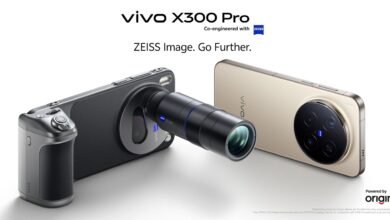
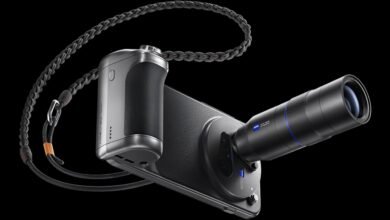
Wow! Just the information I needed and at the right time! Very very very informative for non techies like me. I’ve been agonising over which wireless option to get given that Safaricom HOME Fibre isn’t yet installed at my place of residence. This article gives context to a lot of the bits of information I’ve gathered as I tried to research on alternatives to home fibre.
Which one is available in muranga county
has anyone tried internet solutions home 5mbps burstable to 20mbps at 6000..what was your experience
Anyone tried the Hai Internet by Liquid Telecom? What’s your experience?
i live ahero, in kisumu county which one is available there (home connection)
I’ve used Telkom 4G internet for close to 2 years and it has served me well. Over the last 4 days however, the speed has dropped so much that it reminds me of the days of dial up. Speed test results are 0.11Mbps download and 0.09Mbps upload. They claim that its because of increased data usage with a lot of people working from home owing to the COVID 19 crisis. Probably not true because other networks appear to be fine. I am searching for an alternative. I don’t live in Nairobi.
This was a very informative and well researched article by the OP.
On your issue, referencing the above article, you may be subject to Fair Use Policy. This will be true due to increase in many people due to the Covid-19 crisis, and that they had no flexible ‘hardware’ to scale up with demand (not planned for or caught by surprise by Covid-19 issues, or financial constraints to scale up on hardware), just like a server working well for 20 people will strain under 40 people, unless second server is brought alongside, etc.
great article man. Really informative loved it.